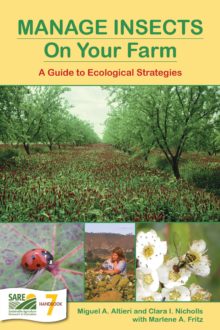Farm Feature No-Till Cover Crops Yield Soil and Pest Benefits
- Uses conservation tillage, manure and cover crops to manage pests
- Uses cover crops to conserve moisture
- Integrates crop and livestock operations
With slopes as steep as 7 percent and winds that sandblast his seedlings, Mark Vickers decided to try no-till production and cover crops on his Coffee County, Ga., farm nine years ago. A fourth-generation cotton and peanut grower who also plants corn or soybeans when the market is right, Vickers assumed his conservation-tillage system would keep his highly erodible soils in place.
It did that, but it also did a whole lot more. Along with regular manuring with poultry litter, Vickers’ new farming practices eased many of his pest problems. Moreover, it made a “night and day” difference in his soils. “There’s just no comparison,” he says. “It’s beginning to resemble potting soil rather than clay.”
Production costs decrease by up to a third
With the cover crop acting much like “a jacket,” Vickers’ healthier soils hold moisture, prevent runoff and stretch his irrigation dollars. In its entirety, his farming system trims a quarter to a third off Vickers’ production costs — mostly for labor, equipment and fuel. He sidedresses a bit of nitrogen and applies several conventional herbicides, but cutting back to just one preplant insecticide in his peanuts slashed the insecticide share of his budget by 50 to 60 percent.
Vickers now plants Bt cotton against bollworms and hasn’t used insecticides against any cotton pests for the past two years. Ladybugs, fire ants, wasps, assassin bugs and bigeyed bugs are abundant in his fields. “It took between three and four years to build up the beneficial populations,” he says. “I still have the same pests, but the beneficials seem to be keeping them in check and not letting them get over the threshold numbers.”
Historically, Vickers has rarely been plagued with insects in his peanuts. When corn earworms uncharacteristically erupted last year, he treated them with pyrethroids. On the other hand, infestations of white mold and tomato spotted wilt virus were common occurrences before Vickers began using cover crops. He hasn’t seen either of those diseases in his peanuts since.
Standout cover crop is rye
Although Vickers grows wheat, rye and oats as high-residue winter covers — and also sells the oats — it’s the rye that’s made him a believer in the value of cover crops. He uses it to prevent root-knot nematode problems and credits it with “dramatically” boosting his weed control, deterring weeds and “shading everything out.”
Vickers sows his cover crops all the way to his field edges and even into his roads. He feeds them lightly with nitrogen if he thinks they need it. In spring, when he plants his summer cash crop, he kills the cover crop with a herbicide and plants either peanuts or cotton right into the standing litter. When he grows corn, he sows that directly into the green cover crop.
Vickers’ improved farming practices let him produce profitable cash crops without hiring labor. “I do all of it myself — everything — but there’s plenty of time to do it,” he says. “If I weren’t doing it this way, I couldn’t farm. There would not be enough time for me to do everything that needed to be done to plant a crop.”
Minimum-till: From “no way” to a better way
Mike Nugent, another Coffee County cotton and oat grower, says his minimum-till system has increased his cotton yields by half — to about 1,250 pounds of cotton lint per acre. Nugent plants an oat cover crop in late fall, lets his cattle graze it for a few months in winter and still harvests 80 bushels of certified oat seed per acre in spring. He irrigates about 40 percent less than the county’s conventional farmers and saves $30 to $40 an acre on insecticides, not including application costs.
“If you had told me 10 years ago that I would be farming no-till, I would have laughed at you and said there was no way in the world that would work,” says Nugent.
However, when he began easing into his new system seven years ago, he was struck by how many more beneficials inhabited his cover crop than his still-conventional fields. It’s been three years now since Nugent last sprayed his cotton for budworms or bollworms. He uses herbicides in his Roundup Ready® cotton and treats his seed with fungicides, but he relies on scouting to manage his insect pests.
“You have to watch what you’re doing,” he says. “If they ever get out of hand, we’ll have to spray them. But we let the populations get to a certain point, because the beneficials won’t stay without anything to eat.” Even when pest populations reach threshold levels, Nugent keeps scouting for another few days. “I’ve seen lots of times, when you wait one day and scout again, the population comes down — and once it comes down, it will keep coming down every day.”
Less tillage, fewer weeds
The very first year he strip-tilled, Nugent also noticed many more weeds where he tilled than where he didn’t. He responded by narrowing the tilled strip and now needs a third less herbicide.He also uses very little commercial fertilizer, depending instead on poultry litter and on recycled nutrients that are pulled from the ground by his oats and returned through their dead straw.
In the beginning, his neighbors were skeptical. Now, Nugent says, “they’ve switched over, too, because they’ve seen that it works. It’s the only way to farm, as far as I’m concerned.”
